If you’ve been sidelined by nagging injuries or struggling with recovery after intense training, you may have come across TB-500. Known for its powerful healing properties, TB-500 is a synthetic peptide designed to mimic the effects of Thymosin Beta-4—a naturally occurring compound involved in tissue regeneration and cellular repair. While it's not FDA-approved for human use, athletes, bodybuilders, and even biohackers are turning to TB-500 to recover faster, improve mobility, and enhance overall soft tissue health. But is it safe? How much should you take? And should you stack it with other peptides like BPC-157?
This beginner’s guide covers everything you need to know about TB-500, including how it works, the benefits it offers, optimal dosage protocols, side effects, legality, and how to stack it for maximum results.
What Is TB-500?
TB-500 is the synthetic version of a naturally occurring peptide called Thymosin Beta-4 (Tβ4)—a protein found in nearly all human and animal cells that plays a critical role in tissue repair and regeneration. TB-500 was designed to mimic the regenerative effects of Tβ4, but with improved stability and bioavailability for therapeutic use. While it's not approved for human medical treatment, TB-500 has gained traction in the performance and wellness communities for its reported ability to accelerate recovery from soft tissue injuries.
Unlike many peptides that target specific receptors or tissues, TB-500 works systemically. Once injected, it spreads throughout the body and binds to G-actin, a key protein involved in cell structure and movement. This interaction allows TB-500 to stimulate angiogenesis (the formation of new blood vessels), enhance cell migration, and promote tissue remodeling—all essential processes for healing damaged muscles, ligaments, tendons, and even skin.
Though commonly discussed in bodybuilding circles, TB-500 is more than just a performance enhancer. Its roots lie in regenerative medicine and even veterinary use, where it has been studied for wound healing in horses and dogs. In humans, its popularity stems from anecdotal success stories, especially among those dealing with persistent injuries or recovering from surgery.
Because it’s considered a research chemical, TB-500 is not regulated as a pharmaceutical and should only be purchased from reputable suppliers. Still, it remains a compelling option for those seeking advanced healing and recovery tools—especially when used alongside peptides like BPC-157.
How TB-500 Works in the Body
The core mechanism behind TB-500’s healing potential lies in its ability to regulate actin, a protein that plays a vital role in cell structure, movement, and signaling. TB-500 binds to G-actin (globular actin), helping to balance actin polymerization and enabling cells to migrate to sites of injury more efficiently. This cellular movement is essential for wound healing, tissue regeneration, and reducing inflammation.
In addition to supporting cell migration, TB-500 promotes angiogenesis—the development of new blood vessels from pre-existing ones. Increased blood flow to damaged tissue delivers critical nutrients and immune cells, which accelerates the recovery process. It also helps reduce fibrotic tissue formation, supporting more complete and functional healing, particularly in connective tissues like tendons and ligaments.
Unlike localized peptides such as BPC-157, TB-500 has a systemic effect, meaning it circulates throughout the body rather than acting only at the injection site. This makes it especially useful for generalized pain, bilateral injuries, or when the precise injury site is difficult to target.
“Thymosin beta-4, and by extension TB-500, acts primarily through actin binding and mobilization, facilitating angiogenesis, cell migration, and tissue repair.”
— Zou, Frontiers in Pharmacology
Emerging research also suggests TB-500 may have anti-inflammatory properties, helping to reduce oxidative stress markers and promote mitochondrial function in damaged tissue. These systemic and multifaceted actions make it a versatile recovery agent for both acute injuries and chronic inflammation.
Benefits of TB-500 for Beginners
For individuals new to peptide therapy, TB-500 offers a compelling set of recovery-enhancing benefits. Its reputation stems not from muscle growth or fat loss, but from its profound ability to support soft tissue healing—making it particularly useful for bodybuilders, athletes, and anyone recovering from injury or overuse.
Key Benefits of TB-500:
-
Accelerated Healing of Muscles, Tendons, and Ligaments
TB-500 promotes faster repair of connective tissue and muscle fibers. It is often used after acute injuries or surgeries to help reduce downtime and support more complete recovery. -
Improved Joint Function and Mobility
Users frequently report reduced stiffness and increased range of motion, especially in problematic joints or areas with chronic inflammation. -
Reduction in Inflammation
TB-500 exhibits anti-inflammatory properties, making it useful for chronic pain conditions or inflammatory injuries like tendonitis or bursitis. -
Enhanced Angiogenesis (Blood Vessel Formation)
More blood flow means better nutrient and oxygen delivery to damaged tissue. This supports both healing and functional regeneration. -
Systemic Healing Effects
Unlike peptides with localized action, TB-500 travels throughout the body. This makes it ideal for treating widespread or bilateral injuries, or when the exact injury site is unclear.
“TB-500’s systemic distribution and angiogenic properties give it an advantage in supporting recovery from both localized and generalized musculoskeletal injuries.”
— Crescioli, Clinical Peptides
Beginners often start with TB-500 when other interventions (physical therapy, NSAIDs, cortisone injections) haven’t provided full relief. It’s especially popular in sports that involve repetitive joint stress—such as CrossFit, bodybuilding, powerlifting, and endurance sports.
When combined with BPC-157, TB-500 forms the foundation of one of the most effective peptide-based recovery stacks available today.
TB-500 Dosage Guidelines for Beginners
Beginner users typically start with TB-500 during an injury recovery phase, surgical rehab, or as a preventive measure for chronic soft tissue strain. While there is no officially sanctioned dosing protocol due to its classification as a research peptide, several well-established practices exist based on clinical research and anecdotal reports from athletic use.
Typical TB-500 Dosage Protocol
-
Loading Phase:
2 to 2.5 mg twice per week for the first 4–6 weeks
(Total: 4–5 mg per week) -
Maintenance Phase:
2 mg once every 1–2 weeks as needed for ongoing recovery or injury prevention -
Cycle Duration:
Common cycles run 4–6 weeks for acute injuries
Chronic injuries may require 8–12 weeks with a tapering maintenance schedule
Injection Method
-
Reconstitution: TB-500 typically comes in lyophilized powder form and must be reconstituted with bacteriostatic water before use.
-
Administration Route: Subcutaneous (subQ) or intramuscular (IM) injections
-
Because TB-500 has a systemic effect, injection site selection is not critical, unlike localized peptides such as BPC-157.
-
Timing Considerations
-
Best taken away from food to optimize absorption
-
Some users inject in the evening to take advantage of overnight tissue repair
-
For joint-specific healing, TB-500 can be paired with localized injections of BPC-157 for targeted support
Peptides like TB-500 are delicate molecules. Always use sterile technique during reconstitution and injection, and discard any reconstituted peptide after 14–20 days if not refrigerated properly.
Stacking TB-500 With BPC-157
For beginners seeking maximum recovery benefits, stacking TB-500 with BPC-157 is one of the most effective and widely used peptide combinations. While TB-500 offers systemic healing by circulating throughout the body, BPC-157 works locally at the site of injury. Together, they create a synergistic repair environment that accelerates tissue regeneration, reduces inflammation, and restores joint mobility.
Why This Stack Works
-
TB-500: Improves actin regulation, angiogenesis, and systemic recovery of soft tissues
-
BPC-157: Enhances local repair of muscle, tendon, ligament, and intestinal tissue
-
Combined Effect: Faster healing, stronger connective tissue, reduced pain and downtime
“BPC-157 promotes tendon, ligament, and muscle healing through modulation of nitric oxide pathways and growth factor expression.”
— Gwyer et al., Current Pharmaceutical Design
“Thymosin Beta-4 (TB-500) enhances wound healing by promoting cell migration and new blood vessel formation.”
— Malinda et al., FASEB Journal
Beginner-Friendly Stacking Protocol
Weeks 1–4 (Loading Phase):
-
TB-500: 2–2.5 mg twice weekly (total: 4–5 mg/week)
-
BPC-157: 250–500 mcg daily (split into two doses, AM and PM)
Weeks 5–6 (Maintenance):
-
TB-500: 2 mg once weekly
-
BPC-157: 250 mcg daily or as needed
Optional Add-On:
-
Consider adding MK-677 to support deeper tissue regeneration through increased natural GH release.
This stack is commonly used during post-surgery rehab, tendonitis flare-ups, chronic knee/shoulder issues, or recovery from connective tissue damage. Because both peptides are well-tolerated when dosed properly, they make a strong entry point for beginners looking to support healing without resorting to more aggressive compounds.
Side Effects and Safety Considerations
While TB-500 is generally well-tolerated, it’s important for beginners to understand the potential risks associated with its use—especially because it’s not approved for human consumption and lacks long-term clinical data. Most reported side effects are mild, but concerns remain around sourcing quality and theoretical risks tied to its biological actions.
Reported Side Effects
-
Fatigue or lethargy
-
Mild headache or dizziness
-
Flushing or lightheadedness after injection
-
Injection site irritation (swelling, redness, or discomfort)
These effects are typically transient and resolve quickly with dose adjustment or improved injection technique. Most anecdotal user feedback reports few to no side effects when TB-500 is used responsibly.
“No major adverse effects have been documented in short-term preclinical or veterinary studies, but data on long-term human use remains limited.”
— Crescioli, Clinical Peptides
Safety and Biological Considerations
One of the primary concerns around TB-500 is its ability to stimulate angiogenesis—the formation of new blood vessels. While this is beneficial for healing, it could, in theory, promote tumor growth if used in someone with undiagnosed cancer or pre-cancerous conditions. This makes oncological screening and conservative cycling essential for anyone considering longer-term use.
“The angiogenic potential of thymosin beta-4 may support neovascularization but could present risks in individuals with tumor-prone conditions.”
— Goldstein & Hannappel, Annals of the New York Academy of Sciences
Additionally, because TB-500 is typically sold as a research peptide, the quality can vary significantly between suppliers. Low-purity peptides may contain endotoxins, contaminants, or incorrect amino acid sequences, all of which can trigger immune reactions or reduce efficacy.
Guidelines for Safe Use
-
Use sterile technique for reconstitution and injection
-
Source only from highly reviewed, third-party tested peptide suppliers
-
Avoid use if you have a history of cancer, blood disorders, or autoimmune disease
-
Stick to moderate-length cycles (4–6 weeks) with rest periods in between
As with any research chemical, it’s your responsibility to weigh the potential benefits against the unknown risks. When in doubt, consult a licensed medical provider who is knowledgeable in peptide-based therapies.
Legal Status and Testing Concerns
TB-500 exists in a legal gray area. It is classified as a research chemical and is not approved by the FDA for human use in the United States or most other countries. That means it cannot legally be sold for consumption, medical treatment, or personal use—but it can be purchased by researchers and institutions for laboratory use under specific disclaimers.
Despite its unofficial popularity in the performance and recovery world, using TB-500 comes with several important legal and regulatory considerations:
U.S. Legal Status
-
TB-500 is not a scheduled substance, but its sale is limited to “research use only” under most peptide vendor policies.
-
It is not approved for medical use, and practitioners cannot legally prescribe it.
-
Possession for personal use is typically not prosecuted, but selling or distributing it for human use violates FDA regulations.
“Peptides such as TB-500 fall under FDA enforcement discretion when marketed for research use only, but manufacturers distributing for human consumption risk warning letters and seizure.”
— U.S. Food and Drug Administration
WADA and Drug Testing
If you are a competitive athlete, TB-500 is prohibited under the World Anti-Doping Agency (WADA) list of banned substances. It falls under the category of “Peptide Hormones, Growth Factors, and Related Substances.”
-
Use of TB-500 can lead to a positive drug test
-
Detection is possible via blood or urine testing, though testing is more common in elite athletics
-
Even off-season use can lead to disqualification if traces are found during testing periods
“Thymosin beta-4 and analogues like TB-500 are prohibited under WADA’s S2 classification and considered performance-enhancing substances.”
— World Anti-Doping Agency (WADA), Prohibited List
International Use
The legality of TB-500 varies internationally. Some countries enforce tighter restrictions, while others allow research compounds more freely. Regardless of location, buying from unregulated or unverified sources increases the risk of contamination, mislabeling, or legal exposure.
Conclusion: Is TB-500 Right for You as a Beginner?
For first-time users navigating the world of performance peptides, TB-500 offers a unique advantage—it’s not designed to boost muscle mass or hormones directly, but rather to enhance the body’s ability to heal itself. If you're recovering from a soft tissue injury, dealing with persistent joint pain, or rehabbing post-surgery, TB-500 may help accelerate the process and improve mobility.
Its systemic action makes it especially useful for those dealing with multiple or hard-to-pinpoint injuries, while its ability to stimulate blood vessel growth and actin-driven cell migration supports healing from the inside out. When paired with a localized peptide like BPC-157, TB-500 becomes even more effective—making it one of the most respected combinations in recovery and injury prevention protocols.
However, TB-500 isn't risk-free. Because it’s not FDA-approved, the burden falls on the user to ensure proper sourcing, dosing, and cycle length. It's best suited for individuals who understand the importance of sterile handling, reputable suppliers, and responsible self-experimentation.
If you're looking for faster recovery without relying on NSAIDs, cortisone injections, or surgery, TB-500 may be a powerful tool in your arsenal—especially when stacked strategically, cycled wisely, and used with realistic expectations.
FAQ: TB-500 Basics for Beginners
Q: How long does it take for TB-500 to start working?
Most users report noticeable improvements in pain, mobility, or inflammation within 2–4 weeks of starting a loading protocol. Acute injuries may respond faster, while chronic or degenerative conditions may require longer cycles.
Q: Can I use TB-500 without BPC-157?
Yes. TB-500 is effective on its own due to its systemic healing properties. However, stacking it with BPC-157 is often recommended for faster and more targeted results, especially for joint-specific or localized soft tissue damage.
Q: Is TB-500 safe for long-term use?
Long-term safety data in humans is limited. Most protocols use TB-500 for 4–6 weeks, followed by a break or maintenance dosing. Because of its potential angiogenic effects, prolonged use without medical oversight is not advised.
Q: Will TB-500 help with muscle growth?
Not directly. TB-500 doesn’t increase anabolic signaling or testosterone—it improves recovery, healing capacity, and tissue regeneration, which can indirectly support training output and performance.
Q: Is TB-500 legal to buy?
Yes—for research purposes only. TB-500 is not approved for human consumption and should only be purchased from suppliers that clearly label it as a research chemical. It is banned by most athletic organizations.
Q: Can TB-500 be detected in drug tests?
Yes. TB-500 is on the WADA banned list, and it can be detected in both blood and urine panels, especially in athletes subject to enhanced anti-doping protocols.







